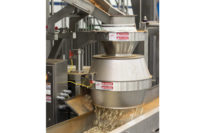Using advanced technology, a cross-functional operational strategy and effective collaboration tools, Blue Diamond’s ‘dream plant,’ a multimillion-dollar almond-processing facility in Turlock, CA, is a reality. The nearly 200,000-sq.-ft. site sets new standards of excellence for food safety, processing and building innovation.
Considered California’s largest agricultural cooperative, representing more than 3,000 California almond growers (it’s also a marketing organization), Blue Diamond Growers, Sacramento, CA, specializes in processing and selling almonds, including slicing, slivering, dicing, blanching, providing them whole and natural and preparing them for use as ingredients.
California’s growers produce more than 80% of the world’s almonds, and Blue Diamond processes and ships the premium almond products to more than 90 countries, with what it refers to as “seamless efficiency.” No question, its business is big: Almonds are marketed to every state in the country and stand as the sixth-
largest U.S. food export and top specialty crop in America. The California almond crop has quadrupled in the past 30 years, with the crop valued this year at more than an amazing $6 billion.
Demand for almond products has been incredible, and a new plant was just what Blue Diamond Growers needed. This is why it decided to build the multimillion-dollar, 175,000-sq.-ft. production facility in Turlock, CA. Ulli Thiersch, plant manager and director of projects and construction, industrial operations, says that Blue Diamond has enjoyed double-digit growth in the last four years, driven by demand in new investment markets and by the ongoing diversification of products containing almonds.
Founded in 1910, the company produces almonds in several forms, including roasted almonds (under the Blue Diamond brand) and nondairy almond milk (under the Almond Breeze brand). The company has introduced 15 new products in the past year, including a gourmet cracker line called Artisan Nut-Thins, in five flavors, and an array of honey-flavored products, such as Honey Roasted Chipotle Almonds and gluten-free snack crackers.
Blue Diamond Growers is an expert at ensuring that its products are in top shape for just about any application, some of which aren’t even around yet. Product quality must be unmatched, and its know-how and services are in place to optimize customer needs.
This almond expert also owns the top spot in snack almonds, almond milk and gluten-free almond crackers in North America, and leads in supplying almond ingredients to major food companies.
But a few years ago, Blue Diamond Growers was at a point where it needed a great deal of additional processing capacity to continue meeting its ever-changing goals, especially at the height of soaring almond popularity. It also wanted to boost global demand and attain several long-term growth targets. That’s when the concept of the Turlock plant was developed.
A multiphase project
“The Turlock plant represents Phase One of a 15-year growth strategy, developed three years ago, that helps Blue Diamond answer the question of how we will compete in the future,” explains Thiersch. Deemed to be the largest single almond investment in the company’s history, the plant opened in April 2013.
“It supports the significant growth in our global almond ingredients business with a facility that sets new standards for food safety,” states Mark Jansen, Blue Diamond president and CEO. “While increasing our capacity and enhancing our capabilities, we are also able to produce efficiencies that allow us to confidently invest, knowing there is significant payback to growers for their investment.”
Staffed (so far) with 95 employees, the sophisticated plant features new principles of building design and delivery, created by a group of Blue Diamond process designers, operations experts, supply chain and quality control (QC)/quality assurance (QA) managers and many more who were involved from the beginning.
Designed to meet world standards for the highest food quality, the facility is located on an 88-acre parcel of land purchased in 2010. A three-phase facility-and-capacity-expansion schedule was developed, and the company broke ground to build the plant in 2012.
The present facility represents nearly half of the capacity-enhancement project, which is scheduled to be completed over the next decade or so. The first phase of the expansion will meet growing global consumer demand for value-added almond ingredients. Some of the end product applications from the ingredients side include cereals, snack bars, baked goods, yogurt toppings and confections.
“Final plans call for a facility that exceeds 400,000 sq. ft. upon completion of the three phases,” says Bruce Lish, general manager of industrial operations.
Nearly all of the production in Phase One at Turlock serves Blue Diamond’s global ingredients manufacturing business to supply almonds as an ingredient to major consumer product groups. The manufacturing plant is outfitted with three almond-processing lines. One line processes and pasteurizes raw almonds without de-skinning them; the two other lines blanch, pasteurize and de-skin the almonds. Each line can also slice, dice and further prepare the almonds for use in baked goods and confections and as other ingredients.
Blue Diamond’s other almond-processing plants are based in Sacramento and Salida, CA. The Salida operation is capable of processing approximately 1 million lb. of raw (brown) almonds a day. Current production at Turlock is designed in part to replace the company’s existing almond blanching and cutting operations in Sacramento, which isn’t as conducive to high-volume, high-efficiency production, reports Lish.
Production rates of blanched almonds at the new facility, for example, where the almond skin is removed, are three times that of the line at the older building. Output is further enhanced through technology and automation that reduces manual tasks that would have otherwise been performed.
Soon, the new plant will enter Phase Two and expand with oil roasting, dry roasting, coating and packaging of whole almonds as well as technologies such as milling for almond milk.
The Sacramento plant is still operating and oil roasts, dry roasts and grinds almonds into paste and almond butter. A clean room environment that complies with Safe Quality Food (SQF) regulations and production under one roof were key considerations in the Turlock plant’s design, Lish explains. “We are [now] better able to keep the product safe and in a pristine environment to improve rates while maintaining quality.”
Separation for food safety
The Turlock plant’s clean-room technology and continuous-flow design completely separate raw materials from finished goods.
“We’re pleased that this is an important industry first, which greatly diminishes the potential for cross contamination,” adds Lish. “We also are able to very quickly switch products and packaging to enhance our manufacturing flexibility.”
Phase Two of the project will also focus on meeting the growing needs of Blue Diamond’s North American consumer group and expand into packaging such as cans, flexible pouches, standup pouches and other formats. This includes packaging for the new honey roasted almonds line in Honey Roasted Chipotle, Honey Roasted Vanilla, Honey Roasted Cinnamon and Regular Honey Roasted flavors. “We anticipate that Phase II will be nearly equal in size to Phase I. Work is underway to determine the scope of Phase II, which should be complete in three to five years,” adds Lish.
Phase Three will focus again on enhancing products and processes that serve Blue Diamond Grower’s global ingredients manufacturing division, says Thiersch.
An incredible feat
Incredibly, the state-of-the-art plant was completed on time and on budget, says the plant project team, which included Lish and experts from the operations group. When the team began the extensive plant-development project, it came up with what it wanted its “dream plant” to look like. Many aspects of the plant design—from product and processing areas to walls, roofs and offices—were imagined using a three-dimensional modeling and visualization approach that helps food plants make better decisions and catches problems early on.
The extra cost of “higher-value” finishes and construction materials and methods were offset by creatively streamlining many systems and using many modular building systems and equipment. The ultimate design included a unique set of removable and reusable concrete panels that form a wall that can be disassembled and reassembled when the company calls for future construction. “It seamlessly connects the future expansion areas to existing building spaces without the operational limitations of traditional knockout openings, while saving operational costs and some future construction costs,” explains Thiersch.
Versatile controls, packaging
Blue Diamond runs the plant at desired production speeds in eight-hour shifts, five days a week, and employees are continuously trained and tested for certifications in their areas of expertise. The almond lines boast several advantages over previous system designs, including the ability to operate continuously rather than batch processing. The Turlock lines can also switch from dicing, slicing or slivering quickly, whereas earlier processing lines had to shut down and retool for such product changeovers.
The processing lines integrate with five packaging lines, so assorted product stock-keeping units (SKUs) can be produced in many package configurations and can be switched over to a different product or packaging type at a moment’s notice. Fully automated process controls feature Allen Bradley 700 systems, with local programmable logic controls (PLCs) and an Ethernet backbone, says Thiersch. Based on custom-built architecture, the control systems measure such things as product flow rates, temperatures, moisture, bin levels and equipment speeds to provide feedback for harmonious production. Control panels are strategically positioned throughout the production areas to allow personnel to get instant access to current data and to make the proper adjustments to processing equipment and packaging systems.
Currently, each production line operates in its own 50-ft.-wide bay that’s adjacent to the others. “Each of the three lines is set up to produce whole almonds, as well as sliced, slivered or diced product of different specifications, by engaging or bypassing components of the cutting system,” Thiersch notes.
Lish says more production lines will be added as needed. The product portfolio required for future growth will dictate the process and packaging requirements,” he says.
A structural second floor above the processing area houses secondary equipment and separate control rooms for each of the processing lines. Thiersch says the company also wanted the pasteurizing space to be free of any burners, fans, filtration units and other mechanical/electrical equipment to improve food and employee safety. “The typical approach of a roof-hung equipment area, isolated with insulated metal panel ceilings, was impractical, due to the load requirements of the wall,” he explains.
Wastewater flows to a pair of 3,000-gallon tanks in an adjacent building, where its screened and solids are removed. Water is recycled to provide added energy savings.
Outside, the facility features drought-tolerant plants and an external irrigation system that measures the moisture and temperature of the air, adjusting landscape irrigation automatically. These and several other factors will allow Blue Diamond to also obtain Leadership in Energy & Environmental Design (LEED) Silver certification later this year. In fact, Turlock will be Blue Diamond’s first LEED-certified plant.
Well-deserved recognition
After a banner opening year, the state-of-the-art plant in Turlock was also named “Plant of the Year” for 2014 by Snack Food & Wholesale Bakery’s sister publication, Food Engineering. The honor annually recognizes the most innovative new food or beverage plant built in North America, and joins past winners including Chobani, Pepperidge Farm and Nabisco.
“The Turlock plant supports the significant growth in our global almond ingredients business with the most food-safe almond-processing facility in existence,” Jansen notes. “The team at Blue Diamond was able to move from ground breaking to startup in 13 months, which was extraordinary.”
Editor’s Note: Photography for and portions of this article were written for and published in the April 2014 issue of our sister publication, Food Engineering. Snack Food & Wholesale Bakery wishes to thank FE for its assistance.








